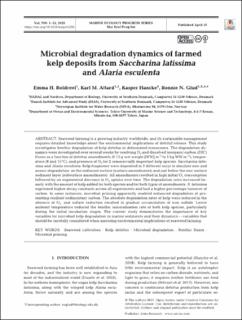| dc.contributor.author | Boldreel, Emma H | |
| dc.contributor.author | Attard, Karl M. | |
| dc.contributor.author | Hancke, Kasper | |
| dc.contributor.author | Glud, Ronnie N. | |
| dc.date.accessioned | 2023-04-19T08:47:01Z | |
| dc.date.available | 2023-04-19T08:47:01Z | |
| dc.date.created | 2023-04-18T12:52:59Z | |
| dc.date.issued | 2023 | |
| dc.identifier.citation | Marine Ecology Progress Series. 2023, 709, 1-15. | en_US |
| dc.identifier.issn | 0171-8630 | |
| dc.identifier.uri | https://hdl.handle.net/11250/3063739 | |
| dc.description.abstract | Seaweed farming is a growing industry worldwide, and its sustainable management requires detailed knowledge about the environmental implications of detrital release. This study investigates benthic degradation of kelp detritus in defaunated mesocosms. The degradation dynamics were investigated over several weeks by resolving O2 and dissolved inorganic carbon (DIC) fluxes as a function of detritus amendments (0.15 g wet weight [WW] m-2 to 1 kg WW m-2), temperature (8 and 15°C), and presence of O2 for 2 commercially important kelp species: Saccharina latissima and Alaria esculenta. Kelp fragments were deposited in 2 different ways to simulate oxic and anoxic degradation: on the sediment surface (surface amendments) and just below the oxic surface sediment layer (subsurface amendments). All amendments resulted in high initial O2 consumption followed by an exponential decrease in O2 uptake over time. The degradation rates increased linearly with the amount of kelp added for both species and for both types of amendments. S. latissima expressed higher decay constants across all experiments and had a higher percentage turnover of carbon. In some instances, microbial priming apparently enabled enhanced degradation of pre-existing resilient sedimentary carbon. The absolute degradation rates of kelp were reduced in the absence of O2, and sulfate reduction resulted in gradual accumulation of iron sulfide. Lower ambient temperature reduced the benthic mineralization rate of both kelp species, particularly during the initial incubation stages. The current study demonstrates the importance of key variables for microbial kelp degradation in marine sediments and their dynamics—variables that should be carefully considered when assessing environmental implications of seaweed farming. | en_US |
| dc.language.iso | eng | en_US |
| dc.publisher | Inter-Research Science Publisher | en_US |
| dc.rights | Navngivelse 4.0 Internasjonal | * |
| dc.rights.uri | http://creativecommons.org/licenses/by/4.0/deed.no | * |
| dc.title | Microbial degradation dynamics of farmed kelp deposits from Saccharina latissima and Alaria esculenta | en_US |
| dc.type | Peer reviewed | en_US |
| dc.type | Journal article | en_US |
| dc.description.version | publishedVersion | en_US |
| dc.rights.holder | © The Authors 2023 | en_US |
| dc.source.pagenumber | 1-15 | en_US |
| dc.source.volume | 709 | en_US |
| dc.source.journal | Marine Ecology Progress Series | en_US |
| dc.identifier.doi | 10.3354/meps14285 | |
| dc.identifier.cristin | 2141585 | |
| dc.relation.project | Norges forskningsråd: 267536 | en_US |
| dc.relation.project | ERC-European Research Council: 669947 | en_US |
| cristin.ispublished | true | |
| cristin.fulltext | original | |
| cristin.qualitycode | 2 | |

